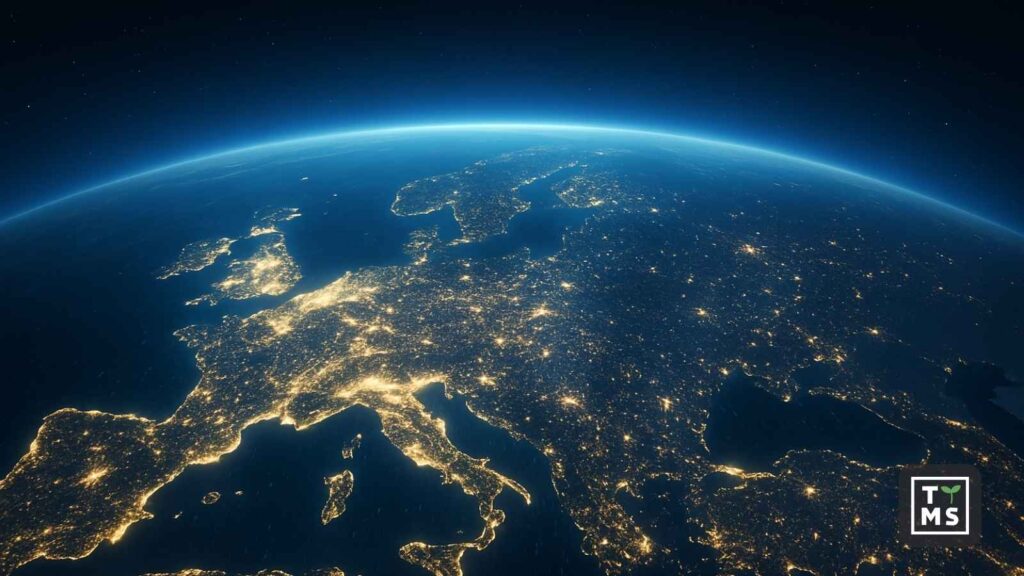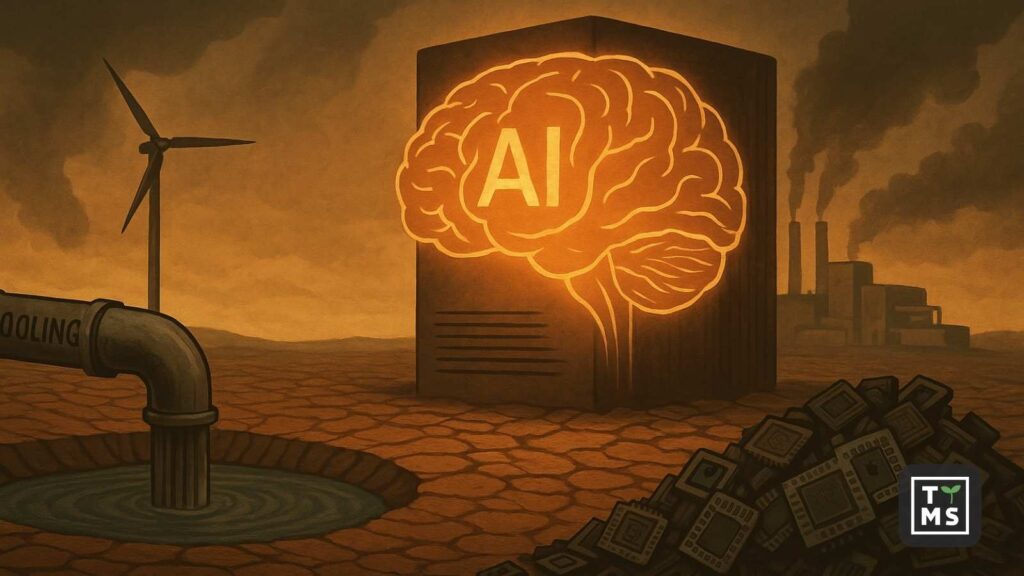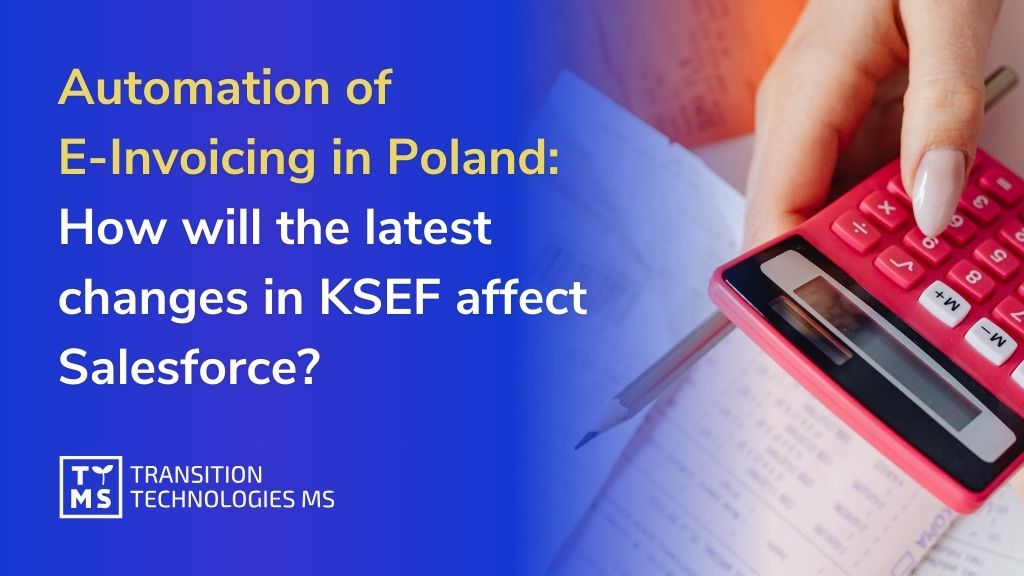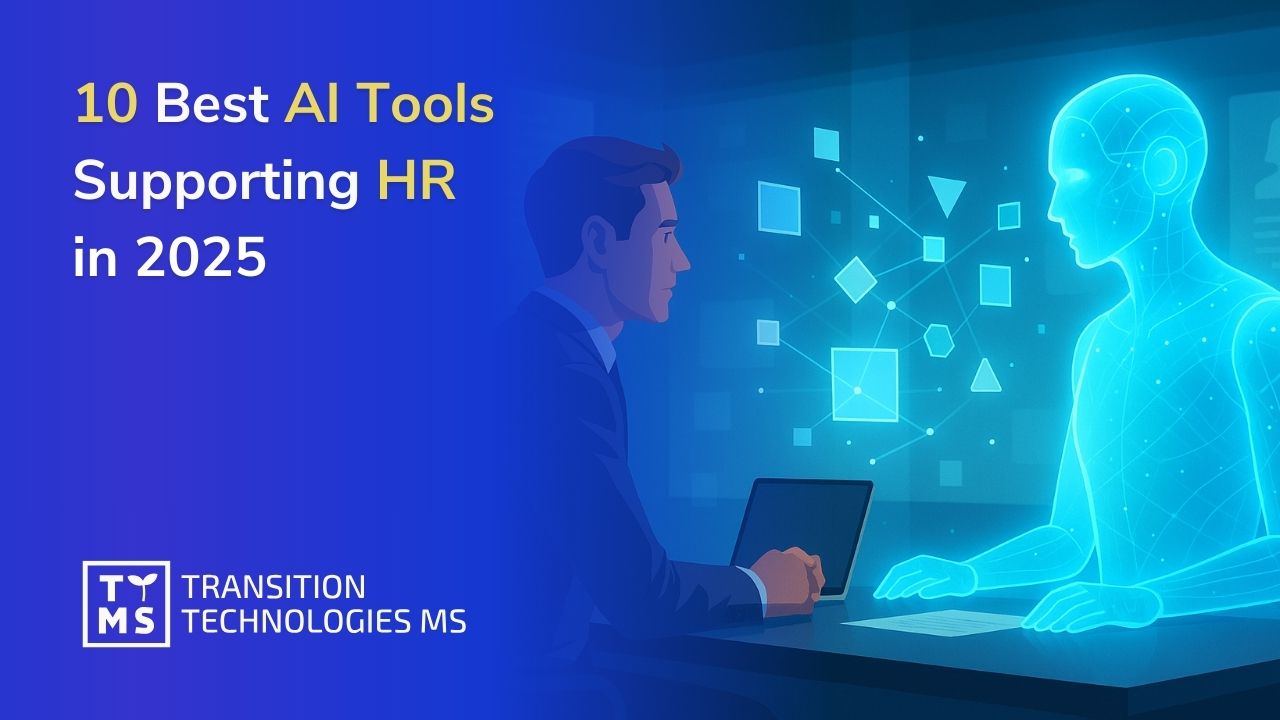In April 2025, OpenAI published its EU Economic Blueprint, a vision of how Europe can harness the potential of artificial intelligence to drive economic growth. The Blueprint was released during a period of intense dialogue between OpenAI and European policymakers — the company’s European tour symbolically began in Warsaw. The document strongly emphasizes the idea of “AI developed in and for Europe”, meaning technology that is created and deployed by Europe, for the benefit of Europe.
Below, we present a comprehensive analysis of the Blueprint’s key proposals, projections for how EU decision-makers may respond, Poland’s potential role as a leader in shaping the future of AI, and a critical look at the environmental challenges posed by the planned boom in computational power.
Key Proposals in OpenAI’s Economic Blueprint
OpenAI presents a range of strategic initiatives designed to accelerate the development of AI within the EU. The most important include:
- Triple compute capacity by 2030: The proposed AI Compute Scaling Plan aims to increase Europe’s compute infrastructure by at least 300% by 2030. It places particular emphasis on building a geographically distributed network of low-latency data centers optimized for AI, especially the inference phase — the point at which trained models are deployed and generate outputs. The EU has already begun taking steps in this direction, committing approximately €200 billion to digital infrastructure (including supercomputers), and France alone is investing €109 billion in its own national initiatives. OpenAI, however, calls for a significant acceleration of these efforts to ensure Europe does not fall behind global competitors.
- €1 billion AI Accelerator Fund: The creation of a dedicated €1 billion fund to finance high-impact AI pilot projects with measurable societal or economic value. The AI Accelerator Fund would help demonstrate the real-world benefits of AI in various sectors by supporting early-stage innovations that solve pressing problems.
- Investment in Talent and Skills: To ensure Europe has the human capital to develop and scale AI, OpenAI proposes the upskilling of 100 million Europeans in AI fundamentals by 2030. The plan includes free online courses available in all EU languages, an “AI Erasmus” program (educational exchanges and fellowships focused on AI), and an expansion of AI Centers of Excellence across Europe. The Blueprint also calls for massive reskilling programs to transition existing workers into AI-relevant roles. The aim is to leverage both Europe’s existing talent (scientists, engineers) and attract global experts — for example, through streamlined visa policies (EU Blue Card reform) and improved working conditions for non-EU AI professionals.
- Green AI infrastructure: AI development must go hand in hand with clean energy investments. The Blueprint emphasizes the need to build a Green AI Grid — an energy system for powering AI infrastructure based on renewables and next-generation technologies. This includes faster permitting for solar and wind farms, development of nuclear and potentially fusion power, and the modernization of electricity grids. The ultimate goal is for Europe’s AI infrastructure to become climate-neutral, in line with EU environmental ambitions — despite a dramatic increase in energy consumption from data centers.
- Open Data at the EU Scale: To unlock Europe’s vast data potential, OpenAI proposes the creation of EU AI Data Spaces by 2027 across key sectors (e.g. healthcare, environment, public services). Europe has a rich pool of data, but much of it is fragmented and siloed. OpenAI advocates for secure, privacy-respecting frameworks that enable cross-border and institutional data sharing. These shared data ecosystems would improve access to high-quality training datasets for AI developers and attract investors to locate compute resources and data hubs within Europe.
- Startup Support and a Unified EU AI Market: To enable startups to scale across the EU, OpenAI recommends establishing a pan-European legal entity for startups by 2026. This legal status would reduce regulatory complexity and allow AI firms to operate seamlessly across all 27 EU member states. The Blueprint also proposes the creation of a European AI Readiness Index — an annual ranking assessing countries’ progress in AI adoption (skills, infrastructure, regulation). By 2027, every EU country should also appoint a national AI Readiness Officer responsible for coordinating national strategy and sharing best practices at the EU level.
- Regulatory simplification – a lighter AI Act: “A house divided against itself cannot stand” — the Blueprint uses this quote to argue that Europe cannot support AI innovation while simultaneously stifling it with overregulation. OpenAI explicitly addresses the AI Act, the world’s first comprehensive legal framework for AI. While supporting its core objective — ensuring safe and ethical AI — OpenAI warns that overly complex regulations could burden innovators and drive AI research outside Europe. It references a report by Mario Draghi, which warned that excessive regulatory complexity in the EU poses an “existential threat” to its economic future. OpenAI calls for trimming redundant or conflicting laws and harmonizing national approaches across the EU. A coherent and simplified legal framework is crucial if AI companies are to scale efficiently — and if citizens are to benefit from innovation on equal terms throughout the single market.

How Will EU Policymakers Respond to OpenAI’s Proposals?
Will Europe embrace these ideas? Reactions from EU decision-makers are likely to be mixed. On the one hand, many of the Blueprint’s directions align with existing EU strategies, suggesting a positive reception. On the other hand, certain recommendations — especially around regulation — may provoke caution or even resistance from some lawmakers. Proposals for investment in infrastructure and talent are the most likely to be welcomed. The EU has long recognized that digital transformation and AI are essential for global competitiveness. Several existing initiatives already mirror OpenAI’s suggestions: multibillion-euro infrastructure funds, the EuroHPC project (developing supercomputers for researchers), the European Chips Act (€43 billion for domestic semiconductor production), and the Horizon Europe program funding AI R&D. The call to triple compute capacity by 2030 may be viewed as ambitious but justified — consistent with the EU’s broader aim of achieving technological sovereignty. Owning its own compute resources, data, and energy for AI would reduce Europe’s reliance on third-party providers — something the European Commission already considers a matter of strategic security.
Similarly, the idea of a €1 billion AI Accelerator Fund sounds realistic within the EU’s economic scale. For comparison, the Digital Europe Programme has a budget of roughly €7.5 billion, part of which is earmarked for AI. It’s conceivable that the Commission or the European Investment Bank could launch a similar fund, especially under increasing competitive pressure from the U.S. and China. OpenAI’s proposals on skills and talent also resonate with current EU goals. The “Digital Decade” strategy sets targets for 2030 — including 80% of adults having basic digital skills and at least 20 million ICT specialists in the EU. Training 100 million citizens in AI basics complements these ambitions. The EU will likely welcome any initiative that strengthens Europe’s human capital in AI, especially given the widespread shortage of IT professionals. Partnerships with private firms (e.g. for multilingual online AI courses) and youth-oriented campaigns may follow. Ideas like an AI Youth Digital Agency, AI Ambassadors Corps, or an EU AI Awareness Day may seem symbolic, but they are politically neutral and easy to implement — and thus likely to gain traction.
Where things may get more complex is regulation, particularly the AI Act. European institutions remain divided. Many lawmakers — especially in the European Parliament and countries like France or Germany — emphasize strong AI regulation, grounded in the precautionary principle and citizen protection. Calls to “streamline” the AI Act may be interpreted as attempts to weaken safeguards. Indeed, in 2023, OpenAI CEO Sam Altman’s warning that overly strict regulation might force OpenAI to withdraw from Europe sparked backlash. EU Commissioner Thierry Breton responded directly, stating: “There is no point in threatening to leave — clear rules do not hinder innovation.”
Nevertheless, there are signs of flexibility. The Omnibus Simplification Package — a regulatory streamlining initiative launched by the Commission — reflects growing awareness of overregulation. Some EU countries, particularly those with pro-innovation agendas, may support OpenAI’s call for harmonization and a reduction in red tape. European Commission President Ursula von der Leyen has previously voiced support for creating a unified EU startup market (“EU Inc.”) and reducing legal fragmentation that limits competitiveness. In this context, the proposal for a pan-European startup legal framework could gain political momentum — especially from business-friendly governments and digital economy advocates.
In summary, the EU is likely to welcome many of OpenAI’s proposals related to investment, skills, and infrastructure. However, it will likely approach regulatory simplification with more caution. Europe is striving to be both a global leader in responsible AI governance and in AI innovation — a delicate balance. The likeliest scenario is not a radical deregulation, but rather: regulatory sandboxes, tax incentives for low-risk AI projects, and more inclusive policymaking processes involving AI experts and industry stakeholders. OpenAI itself seems to acknowledge this: Altman later stated that “we will comply with whatever rules Europe adopts,” while emphasizing that Europe’s best interest lies in embracing AI adoption quickly — or risk falling behind.
Poland as a Potential Leader in AI Transformation
OpenAI’s choice to begin promoting the Blueprint in Warsaw was not accidental. Poland is emerging as a key player in the European AI scene — both in terms of talent and digital policymaking. Chris Lehane, OpenAI’s VP of Public Policy, remarked during his Warsaw visit: “Poland is among the global AI leaders,” citing that Poland ranks in the top five European countries for ChatGPT usage — a sign of strong interest in new technologies across society and business. Human capital is Poland’s greatest AI asset. OpenAI noted that “Polish roots run deep in OpenAI’s DNA” — with many co-founders and leading researchers having Polish backgrounds. Indeed, Polish engineers have played a central role in developing some of OpenAI’s most advanced models. Tech giants such as Google, Microsoft, and NVIDIA have R&D centers in Poland, and OpenAI is reportedly considering Warsaw as a location for its first European office — alongside London and Berlin. Sam Altman praised Poland’s “density of talent” as a decisive factor.
Poland also holds political leverage. In the first half of 2025, the country holds the EU Council Presidency, allowing it to shape discussions around the EU’s digital agenda. While the AI Act is nearly finalized, Poland can still influence how EU AI strategies are implemented — especially regarding infrastructure, funding, and education programs. During OpenAI’s meetings in Warsaw, the legal environment and opportunities for Polish companies in AI were key themes. Poland appears eager to strike a balance — embracing economic opportunities offered by AI, while also shaping the rules of the game. That positioning may allow Poland to act as a bridge between Big Tech and EU regulators.
Poland’s growing AI startup ecosystem and institutional support are also noteworthy. National programs such as IDEAS NCBR (an AI think tank connected to the National Center for Research and Development) and funding from institutions like NCBR and PARP support machine learning innovation. OpenAI’s collaboration with Warsaw’s AI community — including hackathons and research partnerships — reflects growing trust in Poland’s capacity as a development partner. If OpenAI’s Blueprint is adopted, Poland could pilot some of the initiatives. For example, the country could host one of the new AI data centers planned under the 300% compute expansion goal — in line with the geographical decentralization of infrastructure and bringing new investments and jobs.
Poland could also become a leader in AI education. Top universities (Warsaw University of Technology, University of Warsaw, AGH, among others) already offer respected programs in AI and data science. With modest government support, Poland could position itself as a European center for AI talent development — perfectly aligned with the Blueprint’s vision of “100 million AI-ready citizens.” Politically, Poland’s voice in the EU — particularly after the 2023 change in government — may now carry more constructive weight. If Poland clearly supports parts of the Blueprint (e.g. calling for faster AI investment at European Council meetings), it could help shape EU conclusions and funding programs.
In the past, Poland has taken leadership roles in EU digital policy — such as forming alliances around 5G development or advocating for a common digital market. Now, with the opportunity for a technological leap driven by AI, Poland could become not just a policy recipient, but a co-creator of Europe’s AI future.
Compute Growth vs. Sustainability – A Delicate Balance
The rapid growth of AI brings not only promise, but also major sustainability challenges. While OpenAI’s Blueprint calls for tripling Europe’s compute capacity, it simultaneously emphasizes the need to ensure sufficient clean energy to support this expansion in line with climate goals. But the scale of projected growth raises tough questions: can European energy systems keep up with AI’s insatiable demand for power?
Already, data centers consume a significant portion of global electricity. In 2023, they accounted for approximately 4% of electricity use in the U.S., and with the rise of AI, that figure is expected to triple within five years. Some analysts warn that by 2030–2035, data centers could consume up to 20% of global electricity. Such a spike would pose a serious strain on energy grids and challenge the stability of power supplies. Europe is already in the midst of an energy transition, moving away from fossil fuels and toward renewables — but this transition is complex and time-consuming. If Europe adds a wave of new supercomputing farms and massive server hubs, without matching investments in generation and transmission, it risks blackouts or increased CO₂ emissions, especially if backup comes from coal or gas. To address this, OpenAI proposes an accelerated green transition — fast-track permits for wind and solar farms, investments in nuclear energy, and possibly new sources like fusion — all geared toward meeting AI’s demands. These ideas align with the European Green Deal, but energy infrastructure takes years to build, while compute demand is rising exponentially now.
Beyond carbon emissions, other sustainability concerns include water consumption for cooling (a growing issue amid Europe’s recurring droughts), and the environmental footprint of AI hardware production. Chips and GPUs require rare-earth minerals, often sourced from countries with weak labor or environmental standards. An AI hardware boom could increase pressure on these resources — and accelerate global emissions, even if Europe keeps its own relatively low. Additionally, shorter hardware lifecycles — as firms race to adopt ever more powerful AI chips — may worsen the problem of electronic waste, a challenge Europe is already struggling to manage.
Still, some solutions could help ease the conflict between growth and sustainability. First, energy efficiency must become a design priority — both at the hardware level (e.g., energy-saving chips, efficient cooling) and software level (e.g., optimizing AI models to require less compute for similar results). Researchers are already developing smaller, more efficient AI models as alternatives to massive, energy-hungry neural networks. Second, smart scheduling and grid management can make a difference — for instance, running AI workloads during off-peak hours or in regions with surplus renewable energy. Third, AI itself can support energy optimization, managing smart grids, forecasting demand, and helping reduce waste — turning AI into both a challenge and a solution.
OpenAI’s Blueprint recognizes these trade-offs and calls for AI investments that also accelerate Europe’s green transition. For EU policymakers, this will be non-negotiable: any AI strategy will be judged through the lens of the Green Deal. A 300% compute increase will need to come with clear plans for emissions reduction, energy mix transformation, and possibly green AI standards — such as carbon footprint reporting for large AI projects, or tax incentives for climate-neutral compute centers. Ultimately, responsible AI growth must be both ethical and ecological. If not, AI’s short-term gains could come at the expense of Europe’s long-term sustainability goals.

However, AI can also support sustainability — through energy optimization, predictive maintenance, and smart grid management. OpenAI’s emphasis on Green AI by design suggests that AI can be both a challenge and a solution — if developed responsibly.
Conclusion
OpenAI’s Economic Blueprint offers Europe a strategic vision: a roadmap for becoming a global AI hub through investment, simplification, and sustainable growth. Many of its proposals are compatible with EU priorities — especially in talent development and infrastructure. Regulatory aspects, particularly the push to lighten the AI Act, will provoke more debate but could influence future implementation strategies.
Poland, with its tech talent and increasing international visibility, is well-positioned to champion parts of this agenda. By aligning national initiatives with European goals, it could become a key testing ground for OpenAI’s ideas — and a regional leader in responsible AI development.
Ultimately, the challenge for the EU will be to combine innovation, regulation, and sustainability into a coherent AI strategy. OpenAI’s Blueprint provides momentum — but Europe must now decide how to channel it into actionable, inclusive, and forward-looking policies that benefit all its citizens.
What is the main goal of OpenAI’s Economic Blueprint for Europe?
The Blueprint aims to help Europe become a global leader in AI innovation and deployment. It proposes strategic investments in infrastructure, talent development, and regulatory simplification to accelerate economic growth and technological sovereignty while aligning with European values and sustainability goals.
What does “inference” mean in the context of AI infrastructure?
Inference refers to the process of using a trained AI model to generate predictions, answers, or actions in real-world applications — for example, when ChatGPT replies to a prompt. While training a model is resource-intensive, inference also requires significant compute power, especially at scale. OpenAI emphasizes optimizing infrastructure for inference because it represents the day-to-day, operational side of AI use in businesses and public services.
What is meant by a “pan-European legal entity” for startups?
OpenAI proposes creating a unified legal status that startups can adopt to operate seamlessly across all EU countries. Currently, launching or expanding an AI business in multiple EU member states involves navigating diverse regulatory, tax, and legal systems. A pan-European legal entity would reduce fragmentation and allow for faster scaling — similar to how the “European Company” (Societas Europaea) structure works in traditional industries.
What are “AI Data Spaces” and why are they important?
AI Data Spaces are sector-specific digital ecosystems where organizations (public and private) share high-quality datasets under common rules and standards. For example, a European Health Data Space would allow hospitals, research institutions, and companies to securely share anonymized medical data to develop better AI diagnostics. The goal is to overcome data silos while ensuring privacy, interoperability, and legal clarity across borders.
What is the concept of “AI Readiness Officers” in the EU context?
OpenAI recommends that each EU country appoint an AI Readiness Officer — a high-level coordinator responsible for aligning national AI strategies with EU goals. These officers would track progress, share best practices, and ensure effective implementation of AI-related initiatives across education, infrastructure, and regulation. The role is inspired by similar coordination positions in climate and cybersecurity governance.
What can businesses do today to prepare for the AI-driven transformation outlined in the Blueprint?
Firms can begin by assessing their current digital maturity and identifying areas where AI can drive efficiency or innovation. Investing in upskilling employees — especially through accessible online AI courses — will help build internal capabilities. Additionally, businesses should monitor developments in EU AI regulation (such as the AI Act), participate in national or sectoral AI pilot programs, and explore partnerships in shared data initiatives. Early engagement with these trends can position companies as frontrunners once EU-wide initiatives, like AI Data Spaces or talent programs, become operational.






